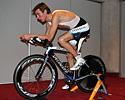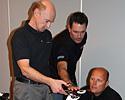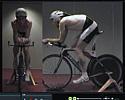
Recently on Cyclingnews.com |
Tech feature, February 3, 2009
The right fit: Shaping Saxo Bank
Comfort, efficiency and performance all matter when it comes to joining rider to bike. The Specialized BG FIT system is being used by the entire Saxo Bank team this season, and represents a significant undertaking by the ProTour squad. Cyclingnews' Shane Stokes watched several key riders undergo the sessions at the team training camp in Portugal.
Continued from Part 1 - where we look at Frank Schleck and Fabian Cancellara.
About Dr Andy PruittDr Andy Pruitt, EdD, PA, is the Director of the Boulder Center for Sports Medicine. He is a former cycling competitor and has been in Sports Medicine for 35 years. His biomechanical interest started while he was at the University of Colorado, and in 1985 he began working with an Israeli biomechanist in digitising and analysing data on cyclists. In the years since he has dealt with a huge number of cyclists, including big US names such as Lance Armstrong, Greg LeMond, Floyd Landis, Bobby Julich and Christian Vande Velde, plus the Italian rider Damiano Cunego. He is regarded as arguably the world's foremost authority on bike fit, and has a long running association with Specialized. He played a big role in designing the company's Body Geometry shoes, which feature a number of ergonomic enhancements. The Saxo Bank team's change to Specialized frames saw Pruitt become involved with the team, and he was commissioned to provide BG (Body Geometry) FITS to all of the riders. He first met up with them towards the end of last year in Copenhagen, fitting them all up for Specialized shoes. He did further adjustments of some of the riders at the team's recent training camp in Majorca, and will do more prior to the Tour of California. Pruitt worked with Italian teams in the past but felt there was a real reluctance to change the status quo. "The American teams have been open to this for ages but with the Italian teams, the doctors were not interested in what we were doing," he told Cyclingnews. "The mechanics were those who were interested as it affected their jobs…they were actually the ones responsible for the positions of their riders, of all things. I find that bizarre." In contrast, he feels that Saxo Bank has been much more open about it. "A lot of teams say 'I want to be comfortable, I want to be fast, but I don't want to change anything'. But these guys say 'I want to be comfortable, I want to be fast, change anything you want'. It's a really nice attitude." For more info, see: http://cdn.specialized.com/bc/microsite/bgfit/bgfit.html |
Andy Schleck - grooming a major Tour contender?

|
His brother Andy Schleck had some similar characteristics. He too had what Pruitt termed "a mild internal femoral rotation" and flat feet. His hamstring flexibility was even worse than Frank's, with his fingers being several inches away from the floor when leaning forward towards the ground. When lying down, this led to a thigh angle of 70 %, considerably less than Cancellara.
Furthermore, an approximate 11 mm difference in leg length was determined, with his right tibia being shorter than the left. A 5mm lift under his shoe was recommended to help compensate for this.

|
Schleck's glute flexibility was slightly less than that of his brother, with 126 and 128 degrees being measured for his right and left sides. The strength of that muscle was found to be weak.
In contrast to Cancellara, who is a time trial specialist, the brothers excel on other terrain. This modified Pruitt's approach, he said afterwards. "Their power is really their strength to weigh ratio on the climbs," he explained. "We want to make sure that they don't lose time in the time trial stages. So we have to make the best advantage of them on their time trial bikes. Bjarne believes - and I don't disagree - that he wants to mimic their hip and knee angles from the road bike. We just roll them forward and maintain their exact same sacral, knee and ankle angles into the most aerodynamic position we can take them into, keeping that power position.
"Although Andy is not flexible, we are going to end up dropping him lower than where he had been. We were able to roll him forward and when we dropped his elbows, that dropped his shoulders and made him more aerodynamic. We will actually lower his stem. But we had to bring Frank the other direction to maintain those angles."
Other riders also benefit
Not all of the Saxo Bank riders were assessed at the training camp in Majorca; Cancellara and the two Schlecks were dealt with there, as well as several others. Another BG FIT session will be done at the team's upcoming training camp in California.
Several changes were made in Majorca, with some of those details as follows:

|
Lars Bak: Perhaps the most dramatic example of how the Specialized BG FIT can work was with Bak. He had several issues, including a visible twisting of his pelvis when riding, complaints of soreness inside his legs and on the right side of his back, plus a visible hunch on his mid-lumbar spine.
Pruitt adjusted his cleat in order to move his left foot forward, and put an additional 1.5mm wedge in Bak's right shoe. This caused him to straighten up on the bike.
More significantly - at least visually - the decision to raise his stem had a dramatic result. The Dane had been riding with the stem too far down, coping by locking his arms. His new position allowed him to support himself better, straighten his lumbar region and actually saw his head and back become lower by 2.5 - 3 centimetres (see photo). This should be both more comfortable and more aerodynamic.

|
Gustav Larson: The Body Geometry assessment led the crew to raise both his bars and saddle on his time trial bike by two centimetres. "This gave him a better leg extension through the power stroke," said Scott Holz, who added that his frontal area remained essentially the same.
Michael Mørkøv: The Dane was one of the least flexible riders on the team and the assessment showed that he needed to have his bars raised almost 2.5 cm on his road bike. He has been given a stretching programme to lengthen his hamstrings.
Jurgen Van Goolan: Had been suffering from chronic tendonitis in his right knee. "We were able to find the cause, and fix it on his bike and pedal setup by moving his right pedal 1/8th of an inch farther outboard from the crank," said Holz.
André Steensen: The Dane had been experiencing pain in his neck and lower back. By shortening his stem by one centimetre, he became more relaxed while still maintaining the same low back profile.
Looking for percentages
As has been seen countless times in sport, the difference between winning and losing can be minute. Even small improvements can have a big effect on the final result. For riders who ride tens of thousands of kilometres per year, bike fit is of fundamental importance; not just for performance's sake, but also for comfort and avoiding injury.
The season ahead will enable the Saxo Bank riders to see if their BG FIT adjustments have made a significant change. Pruitt is confident that there will be clear benefits. "It typically does translate into higher speed," he told Cyclingnews. "They will be faster, longer, because they are comfortable. They may also be faster for short efforts."
He is aware that some of the riders may feel that being lower will be better for their performance. However, as was the case with Lance Armstrong, being too low can lead to significant losses in power. There is a balance to be found between sitting fast and being able to ride the thing, after all.
"Wind tunnel is a position, it is not bike fitting," he warned. "Rarely does a guy come out of the wind tunnel and be able to hold the position they put him in. That is incredibly rare. Most of the time, within 24 hours, it is some muted form of that."
Pruitt said that the next assessment in California would include some wind tunnel measurement, but that the overall holistic approach will be maintained.
"Full aerodynamics will mute physiology, it will suffocate you. A lot of directors just come along and slam everybody's stems right down, thinking they are aerodynamic. But the bike needs to look like the rider, not the other way round."
Photography
For a thumbnail gallery of these images, click here
Images by Shane Stokes
- World time trial champion Fabian Cancellara during his assessment. Recently retired pro Bobby Julich is watching.
- The riders being examined are filmed from front and the side, giving a better picture of any anomalies or position adjustments needed.
- Julich watches while Andy Pruitt and Scott Holz discuss Cancellara's position.
- Pruitt takes some measurements.
- He was impressed by Cancellara's flexibility and strength.
- One way to determine if additional arch support is needed is to get the rider to stand on one leg...
- ...and then bend it, seeing if the knee strays inwards or continues to move only in a vertical direction.
- Holz, Bjarne Riis and Cancellara view the data.
- Andy Pruitt makes an adjustment to Lars Bak's bike. The Specialised stems contain an ingenious asimetrical shim which allows a wide range of angles.
- Bak and Bobby Julich talk during his assessment. Julich has a keen interest in bike fit, having had his position adjusted by Pruitt many years ago.
- Bak pedals under load, allowing the cameras to monitor his movement.
- He was previously sitting crooked on the bike, had a very rounded lower back and complained of groin pain.
- One very interesting consequence of raising his stem one centimetre was that his actual position became lower and more aerodynamic.
- Frank Schleck, being assessed by Pruitt.
- As was the case with most of the riders, number of adjustments were made.
- His saddle was raised slightly, with more to follow when he becomes more flexibile. His stem was also shortened, helping his upper body to relax.
- Although his time trial position is higher than before (as indicated by the yellow line), it is expected that he will be faster. He was previously too low to have been putting out full power.
- The bike belonging to his brother Andy Schleck undergoes some adjustments.
- Schleck is regarded as a strong contender for Tour win. Could it be this year? Time will tell.
- Schleck is watched closely.
- Riis gives his thoughts.
- Although Schleck also has limited flexibility, he is able to get fairly aero on the bike.
- Gustav Larson's position was raised two centimetres, opening up his leg angle and allowing him to put out more power.
- André Steensen had been experiencing pain in his neck and lower back. By shortening his stem by one centimetre, he became more relaxed.

